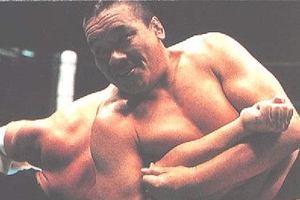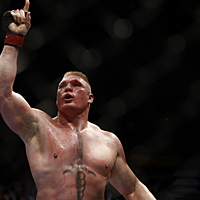
Yoshiaki Fujiwara is long held up as Karl Gotch's best student. In fact out of all of his students, Fujiwara was the only one Karl Gotch willingly endorsed as representative of the 'Gotch Style' of Catch Wrestling. You could say he was Gotch's only 'Black Belt', if such gradings ever existed in catch-as-catch-can.
A Muay Thai kickboxer before a Pro Wrestler, Fujiwara was one of the first graduates of the New Japan Pro Wrestling Dojo that took to the Antonio Inoki 'Strong Style' rather easily as a result, and took part in one of the fist Karl Gotch Cup tournaments in the 1970's.
During the split from NJPW in the mid 1980's that included Satoru Sayama (founder of Shooto), Akira Maeda (founder of Rings), Nobuhiko Takada (star of the first Pride FC show against Rickson Gracie) and Kazuo Yamazaki, these men would band together and form the original Universal Wrestling Federation or UWF. (NB: NJPW owned the 'Tiger Mask' name, so Sayama became 'Super Tiger' to compensate)
Super Tiger (Sayama) vs Fujiwara in an early UWF Pro Wrestling match
Osamu Kido, another NJPW graduate and student of Karl Gotch would join the UWF slightly later. Kido is worth mentioning because of the relationship between him and Gotch being close in the sense of having an adoptive father-son dynamic, and understandably Kido was more distraught than most at Gotch's passing 5 years ago.
Among the group tensions grew between Maeda and Sayama over the direction of the UWF: Maeda wanted it to be more submission based, while Sayama wanted it to be more striking based. Tempers flared to the point where a Shoot Style match between the two became more just Shoot, as they stopped pulling their strikes and went at it on a couple of occasions. One time a match ended when Maeda got himself DQ'd for a non-pulled groin kick!
Maeda was suspended and eventually fired for this, and Sayama would leave because of the continual differences of opinion in direction, the ripple effect leading to the original UWF dissolving.
Karl Gotch training the original UWF Wrestlers. Takada, Maeda, and Fujiwara feature.
UWF was reformed just a few years later as wrestlers who had gone back to NJPW left yet again due to the politics that is a permanent part of pro wrestling globally. Maeda was fired from NJPW for shooting on Riki Choshu: a wrestler thought to be the originator of the famous Scorpion Hold, adopted by North American wrestlers Bret and Owen Hart, as well as Sting under differing names. More relevant to MMA though, Choshu had a freestyle wrestling background in his native South Korea, and was a pro wrestling coach for UFC fighter Riki Fukuda for a short while too.
While still a predetermined Pro Wrestling promotion, the reformed UWF heralded the era of Shoot Style defined by more of a focus on striking and submissions with clean finishes, rather than the theatrical American style that had count-outs and disqualifications among various other shenanigans. In 1989 Fujiwara was granted his release from NJPW to go back to UWF, and took along with him two of his students: Masakatsu Funaki and Minoru Suzuki. Billy Robinson trained Kiyoshi Tamura also made his debut for the UWF that year.
Internal politics combined with a failing Japanese economy lead to this reformed 'Newborn UWF' to close once again. Most of the wrestlers including Takada and Tamura would form UWF International or UWFi, making it an even more Shoot-like promotion that had the endorsement of Pro Wrestlers Lou Thesz, Billy Robinson and Danny Hodge, one of the best American Amateur wrestlers of all time.
Fujiwara, Funaki and Suzuki though founded Pro Wrestling Fujiwara Gumi, while Akira Maeda would form RINGS in 1991.
PWFG wasn't without controversy, as 'Gumi' while meaning 'group' in Japanese was more of a reference to the organised criminal groups of Japan, and Fujiwara adopted the gimmick of being a crime boss of sorts within the promotion.
During the short lived PWFG that also featured the Japan debut of Ken Shamrock (working as 'Wayne Shamrock', his middle name) and Bart Vale (who coined the term Shootfighting as a grappling art he teaches in America), a grappling technique instructional was recorded -- one of the first of its kind -- where Fujiwara, Suzuki and Funaki showed the different phases of the game including their catch wrestling influenced takedowns and submission holds.
The instructional included the following:
Groundwork and Submission Holds with Yoshiaki Fujiwara
Chickenwing Armlock
V1 Armlock
Leg Armlock
Telephone Armlock
Simple entry into the Fujiwara Armbar
Body Scissors
Counter to the Body Scissor
Reverse Leglock
Leg Spread
Achilles' Tendon Hold
Knee Cross Hold
Leg Stamp
Clock Head Scissors
Cross Arm Hold
Triangle Leg Scissor
Takedowns and Submissions Starting from Standing with Minoru Suzuki
Headlock suplex and neck crank
Double-chicken wing takedown and neck crank
Single Leg Takedown Defense and Takedown
Double Arm-Tie Suplex
Pankration, Takedowns, and Submissions from Kicking Defense with Masakatsu Funaki
Suplex and Neck Crank from Opponent's caught Kicking Leg
Go Behind to Takedown and Head Scissor Neck Crank
Rolling Ankle Tackle to Kneebar
To say it was ahead of its time was an understatement, as it predates any video tuition released by the Gracies who had yet to put on the first UFC event in 1993, a couple of years away.
Actually in 1993 just a few months prior to UFC 1, Fujiwara would release his full length grappling instructional 'Submission Master', which also included a bodyweight strength and conditioning workout based off of Karl Gotch's famous 'Deck of Cards' routine. Submission Master featured various armlocks, leglocks, neckcranks and chokes as taught to Fujiwara by Gotch.
A bent armlock instructional from Submission Master 1993
Funaki and Suzuki had a desire to compete, and that lead to them leaving the PWFG to form Pancrase to put the grappling skills they had learned form Fujiwara to the test in a non-complaint, competitive environment, which I will focus on a lot more in the next article.
When PWFG folded, Fujiwara was able to ply his trade in Pro Wrestling for various promotions again including NJPW, but his skills in submission and his ability to teach newer generations at that time was important in Japanese MMA history especially in producing Fuanki and Suzuki who were early pioneers in MMA themselves.
I'll leave you with video of Fujiwara demonstrating variations of his famed Fujiwara armbar. While not the inventor of the move since it's almost impossible to say who invented what during the centuries of grappling history we could look at, he popularised the move enough within professional wrestling for it to be widely known as the Fujiwara armbar, and his variation with the legs is pretty unique too.
Standard Fujiwara Armbar in a pro wrestling match
Fujiwara Armbar variant, original clip from Submission Master 1993

No comments:
Post a Comment